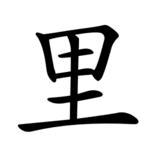Radical 166
Appearance
| 里 | ||
|---|---|---|
| ||
| 里 (U+91CC) "village, li (distance unit)" | ||
| Pronunciations | ||
| Pinyin: | lǐ | |
| Bopomofo: | ㄌㄧˇ | |
| Wade–Giles: | li3 | |
| Cantonese Yale: | lei5 | |
| Jyutping: | lei5 | |
| Japanese Kana: | リ ri (on'yomi) さと sato (kun'yomi) | |
| Sino-Korean: | 리 ri | |
| Hán-Việt: | lý, lí | |
| Names | ||
| Japanese name(s): | 里/さと sato (Left) 里偏/さとへん satohen | |
| Hangul: | 마을 maeul | |
| Stroke order animation | ||
 | ||
Radical 166 or radical village (里部) meaning "village" or "li" (a traditional Chinese unit of distance) is one of the 20 Kangxi radicals (214 radicals in total) composed of 7 strokes.
In the Kangxi Dictionary, there are 14 characters (out of 49,030) to be found under this radical.
里 is also the 157th indexing component in the Table of Indexing Chinese Character Components predominantly adopted by Simplified Chinese dictionaries published in mainland China.
In Simplified Chinese, 裏 or 裡 which mean "inside" is merged to 里.
Evolution
[edit]-
Bronze script character
-
Small seal script character
Derived characters
[edit]| Strokes | Characters |
|---|---|
| +0 | 里 (also SC form of 裏/裡 -> 衣) |
| +2 | 重 |
| +4 | 野 |
| +5 | 量 |
| +11 | 釐 |
Sinogram
[edit]The radical is also used as an independent Chinese character. It is one of the Kyōiku kanji or Kanji taught in elementary school in Japan.[1] It is a second grade kanji[1]
References
[edit]- ^ a b "The Kyoiku Kanji (教育漢字) - Kanshudo". www.kanshudo.com. Archived from the original on March 24, 2022. Retrieved 2023-05-06.
Literature
[edit]- Fazzioli, Edoardo (1987). Chinese calligraphy : from pictograph to ideogram : the history of 214 essential Chinese/Japanese characters. calligraphy by Rebecca Hon Ko. New York: Abbeville Press. ISBN 0-89659-774-1.
External links
[edit]Wikimedia Commons has media related to Radical 166.


